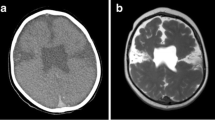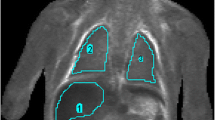Abstract
Objective
To prospectively compare diagnostic accuracy of fetal post-mortem whole-body MRI at 3-T vs. 1.5-T.
Methods
Between 2012 and 2015, post-mortem MRI at 1.5-T and 3-T was performed in fetuses after miscarriage/stillbirth or termination. Clinical MRI diagnoses were assessed using a confidence diagnostic score and compared with classical autopsy to derive a diagnostic error score. The relation of diagnostic error for each organ group with gestational age was calculated and 1.5-T with 3-T was compared with accuracy analysis.
Results
135 fetuses at 12–41 weeks underwent post-mortem MRI (followed by conventional autopsy in 92 fetuses). For all organ groups except the brain, and for both modalities, the diagnostic error decreased with gestation (P < 0.0001). 3-T MRI diagnostic error was significantly lower than that of 1.5-T for all anatomic structures and organ groups, except the orbits and brain. This difference was maintained for fetuses <20 weeks gestation. Moreover, 3-T was associated with fewer non-diagnostic scans and greater concordance with classical autopsy than 1.5-T MRI, especially for the thorax, heart and abdomen in fetuses <20 weeks.
Conclusion
Post-mortem fetal 3-T MRI improves confidence scores and overall accuracy compared with 1.5-T, mainly for the thorax, heart and abdomen of fetuses <20 weeks of gestation.
Key Points
• In PM-MRI, diagnostic error using 3-T is lower than that with 1.5-T.
• In PM-MRI, diagnostic scan rate is higher using 3-T than 1.5-T.
• In PM-MRI, concordance with classical autopsy increases with 3-T.
• PM-MRI using 3-T is particularly interesting for thoracic and abdominal organs.
• PM-MRI using 3-T is particularly interesting for fetuses < 20 weeks’ gestation.








Similar content being viewed by others
References
Syngelaki A, Chelemen T, Dagklis T, Allan L, Nicolaides KH (2011) Challenges in the diagnosis of fetal non-chromosomal abnormalities at 11-13 weeks. Prenat Diagn 31:90–102
Carvalho JS (2004) Fetal heart scanning in the first trimester. Prenat Diagn 24:1060–1067
Chaoui R, Benoit B, Mitkowska-Wozniak H, Heling KS, Nicolaides KH (2009) Assessment of intracranial translucency (IT) in the detection of spina bifida at the 11-13-week scan. Ultrasound Obstet Gynecol 34:249–252
Gordijn SJ, Erwich JJHM, Khong TY (2002) Value of the perinatal autopsy: critique. Pediatr Dev Pathol 5:480–488
Boyd PA, Tondi F, Hicks NR, Chamberlain PF (2004) Autopsy after termination of pregnancy for fetal anomaly: retrospective cohort study. BMJ 328:137
Thayyil S, Chitty LS, Robertson NJ, Taylor AM, Sebire NJ (2010) Minimally invasive fetal postmortem examination using magnetic resonance imaging and computerised tomography: current evidence and practical issues. Prenat Diagn 30:713–718
Griffiths PD, Paley MNJ, Whitby EH (2005) Post-mortem MRI as an adjunct to fetal or neonatal autopsy. Lancet 365:1271–1273
Cannie M, Votino C, Moerman P et al (2012) Acceptance, reliability and confidence of diagnosis of fetal and neonatal virtuopsy compared with conventional autopsy: a prospective study. Ultrasound Obstet Gynecol 39:659–665
Kang X, Cos T, Guizani M, Cannie MM, Segers V, Jani JC (2014) Parental acceptance of minimally invasive fetal and neonatal autopsy compared with conventional autopsy. Prenat Diagn 34:1106–1110
Thayyil S, Cleary JO, Sebire NJ et al (2009) Post-mortem examination of human fetuses: a comparison of whole-body high-field MRI at 9.4 T with conventional MRI and invasive autopsy. Lancet 374:467–475
Thayyil S, Sebire NJ, Chitty LS et al (2013) Post-mortem MRI versus conventional autopsy in fetuses and children: a prospective validation study. Lancet 382:223–233
Kuhl CK, Träber F, Schild HH (2008) Whole-body high-field-strength (3.0-T) MR Imaging in Clinical Practice. Part I. Technical considerations and clinical applications. Radiology 246:675–696
Kuhl CK, Träber F, Gieseke J et al (2008) Whole-body high-field-strength (3.0-T) MR imaging in clinical practice. Part II. Technical considerations and clinical applications. Radiology 247:16–35
Zhang Z, Liu S, Lin X et al (2011) Development of fetal brain of 20 weeks gestational age: assessment with post-mortem Magnetic Resonance Imaging. Eur J Radiol 80:e432–e439
Zhang Z, Liu S, Lin X et al (2011) Development of laminar organization of the fetal cerebrum at 3.0T and 7.0T: a postmortem MRI study. Neuroradiology 53:177–184
Votino C, Jani J, Verhoye M et al (2012) Postmortem examination of human fetal hearts at or below 20 weeks’ gestation: a comparison of high-field MRI at 9.4 T with lower-field MRI magnets and stereomicroscopic autopsy. Ultrasound Obstet Gynecol 40:437–444
Sandaite I, De Catte L, Moerman P et al (2013) A morphometric study of the human fetal heart on post-mortem 3-tesla magnetic resonance imaging. Prenat Diagn 33:318–327
Sandaite I, Dymarkowski S, De Catte L et al (2014) Fetal heart pathology on postmortem 3-T magnetic resonance imaging. Prenat Diagn 34:223–229
Victoria T, Johnson AM, Edgar JC, Zarnow DM, Vossough A, Jaramillo D (2016) Comparison Between 1.5-T and 3-T MRI for fetal imaging: is there an advantage to imaging with a higher field strength? AJR Am J Roentgenol 206:195–201
Cannie MM, De Keyzer F, Van Laere S et al (2016) Potential heating effect in the gravid uterus by using 3-T MR imaging protocols: experimental study in miniature pigs. Radiology 279:754–761
Arthurs OJ, Guy A, Thayyil S et al (2016) Comparison of diagnostic performance for perinatal and paediatric post-mortem imaging: CT versus MRI. Eur Radiol 26:2327–2336
Votino C, Cannie M, Segers V et al (2012) Virtual autopsy by computed tomographic angiography of the fetal heart: a feasibility study. Ultrasound Obstet Gynecol 39:679–684
Sarda-Quarello L, Tuchtan L, Torrents J et al (2015) Perinatal death: Is there a place for post-mortem angio-CT? J Forensic Radiol Imaging 3:1–4
Votino C, Bessieres B, Segers V et al (2014) Minimally invasive fetal autopsy using three-dimensional ultrasound: a feasibility study. Ultrasound Obstet Gynecol
Arthurs OJ, Thayyil S, Pauliah SS et al (2015) Diagnostic accuracy and limitations of post-mortem MRI for neurological abnormalities in fetuses and children. Clin Radiol 70:872–880
Arthurs OJ, Thayyil S, Olsen OE et al (2014) Diagnostic accuracy of post-mortem MRI for thoracic abnormalities in fetuses and children. Eur Radiol 24:2876–2884
Arthurs OJ, Thayyil S, Owens CM et al (2015) Diagnostic accuracy of post mortem MRI for abdominal abnormalities in foetuses and children. Eur J Radiol 84:474–481
Arthurs OJ, Thayyil S, Addison S et al (2014) Diagnostic accuracy of postmortem MRI for musculoskeletal abnormalities in fetuses and children. Prenat Diagn 34:1254–1261
Author information
Authors and Affiliations
Corresponding author
Ethics declarations
Guarantor
The scientific guarantors of this publication are Xin Kang and Jacques Jani.
Conflict of interest
The authors of this manuscript declare no relationships with any companies whose products or services may be related to the subject matter of the article.
Funding
This study has received funding by the Fetal Medicine Foundation Belgium.
Statistics and biometry
One of the authors has significant statistical expertise.
Ethical approval
Institutional review board approval was obtained.
Informed consent
Written informed consent was obtained from all subjects (patients) in this study.
Methodology
prospective, observational, performed at one institution.
Rights and permissions
About this article
Cite this article
Kang, X., Cannie, M.M., Arthurs, O.J. et al. Post-mortem whole-body magnetic resonance imaging of human fetuses: a comparison of 3-T vs. 1.5-T MR imaging with classical autopsy. Eur Radiol 27, 3542–3553 (2017). https://doi.org/10.1007/s00330-016-4725-4
Received:
Revised:
Accepted:
Published:
Issue Date:
DOI: https://doi.org/10.1007/s00330-016-4725-4




